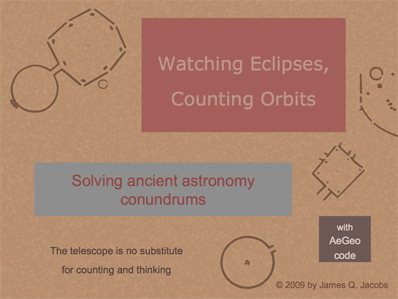| Ancient Astronomy, Integers, Great Ratios, and Aristarchus |
|
Eclipse cycles, by definition, express integer intervals of lunar periods. Integers—whole numbers, serve as fractions when any two are used as a ratio. All fractions equate integers. Decimals are fractions, tenths, hundredths, etc. For pi, the ratio 22 : 7 is approximate, 355 : 113 is more accurate. Ratios of large integers express deep fractions accurately. Integer ratios provide evidence of ancient astronomical knowledge. I noted an Old World 345-year eclipse interval also precisely equals integer numbers of rotations and days. Examination of Aristarchus' 4,876-year "Great Year" revealed a large-integer equation of the three fundamental sidereal motions: solar orbit, lunar orbit, and rotations. This possible import of Aristarchus' interval has gone unnoticed for several millenia, apparently fallen into obscurity along with heliocentrism. A "great ratio" is herein defined as an accurate integer ratio for three or more astronomical periods. Eclipse intervals inherently express cosmic harmonics of two integer-accurate periods, moons and nodal crossings. The approximate 345-year-eclipse-interval great ratio equating 4,267 synodic periods with 4,573 anomalistic periods was known to the Ancient Greeks and Babylonians. In the Epoch Calc conversion tables, I noticed this interval also accurately equates to more integers; in 126,352 rotations there are 126,007 days, per orbit one less day than rotations, 345 fewer days. This great ratio has five integer periods, six when doubled.
Accurate integer equation of lunar synodic with the apogee-perigee period ensures greater interval constancy of eclipse observations. Lunar orbit eccentricity effects speed of orbit during each anomalistic period. Comparing eclipse intervals having whole multiples of the apogee-perigee cycle ameliorates the impact of the inconstancy of orbit speed. Ancient astronomers utilized this knowledge to arrive at more accurate mean period determinations. Hipparchos, who compared eclipses with Babylonian records from 345 years earlier, evidences this astronomical understanding in antiquity. The well-known Saros Eclipse Cycle expresses a great ratio with anomalistic periods (223 : 239 : 242) and the Triple Saros or Exeligmos with integer days additionally (669 : 717 : 726 : 19,756). Eclipse equation with integer days indicates the interval repeats at near the same time of day. The Saros Great Ratio equates eclipses and lunar orbit eccentricity, thus similar eclipses recur. The Exeligmos Great Ratio additionally roughly equates days, thus the eclispe recurrence is near the same diurnal time. Longer intervals proportionally increase observation accuracy, and more accurately express complex fractions with larger integer ratios. Sufficiently large integer ratios express astronomical values precisely. Table 1 compares, using 297 B.C.E. ephemeris astronomical values (Universal Time), days per the six integer multiples in the 345-year eclipse interval. One-half a nodal period multiple (4,630.5) is an eclipse integer; ascending and descending nodes cross the ecliptic each period and both can possibly eclipse. Code used as shorthand herein and in the Tables (i.e. d = day) is introduced in the fundamental astronomy section of Eclipses, Cosmic Clockwork of the Ancients.
Two most accurate integer ratios are with earth sidereal rotations. The most accurate integer ratio with moons is rotations. The three most equal periods of this eclipse cycle are 126,352 rotations : 126,007 days : 4,267 moons.
Use of an eclipse interval which equates accurate integer rotations and days implies earth motion and time of day and of rotation may have had a role in the observations—likely augmenting the accuracy capability. The accuracy of integer anomalistic periods makes this interval a favorable observation choice for those who understand lunar elliptical geometry produces variation in orbit speed. |
||||||||||||||||||||||||||||||||||||||||||||||||||||

